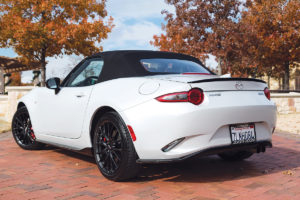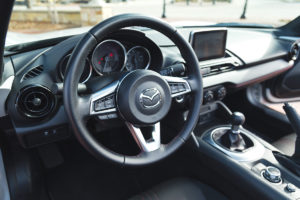As an auto enthusiast, it is slightly embarrassing to admit that before this review, I had never driven a Mazda MX-5 Miata. They tend to be popular with the uninformed “tuners,” who just slap a noisy exhaust on while chugging energy drinks as if it were a religion, and with high school girls, who have no idea what a clutch is. The car is highly regarded by just about every reputable journalist as one of the best handling, most fun and most cost efficient convertibles of all time. After some thought, the concept becomes obvious: rigid, feather-weight construction coupled with a spunky engine. It should be what every wannabe racecar driver wants! With just shy of one million vehicles sold over the last 26 years, Mazda’s sales numbers prove that the formula works.
By the time 1989 came around, cars had been neutered in design and performance due to safety and emission regulations. It seemed that most cars were no longer designed by an artist’s eye and intuition, but by a scrutinizing, unimaginative engineer and his ruler. They were objects of transportation, sacrificing power and passion for better fuel economy and bleak design. The MX-5 was a tribute to what the industry had just lost (for example, classic British roadsters like the MG and Triumph), while providing a vision of what the industry could be. It brought the sensation of driving pleasure back to the market and simultaneously delivered good fuel economy and safety. The market responded loud and clear by buying double what Mazda had anticipated in its first few years of production.
 The 2016 MX-5 resembles very little of its great-grandfather, but is built with the same idea in mind. Its main selling point is its weight, or lack thereof. It weighs just over 2,300 pounds, which is about half the weight of your average midsize sedan, and comes with a 155-horsepower, naturally aspirated four-cylinder engine. There are countless methods of improving the performance of any car, such as adding power, increasing aero downforce or implementing a faster shifting transmission. When you take away weight (and in this case, a lot of it), every aspect of the car gets better. It gives the vehicle a better power-to-weight ratio, makes it nimbler, offers more control, provides better fuel economy, gives the driver better grip, etc. That is why this car does not need a turbo or more cylinders. It is quick! Very quick! Some have gone 0-60 mph in under six seconds, making it one of the quickest cars in its price range and it beats many other vehicles that are almost twice the price. After revving out flubbed gear changes, I still managed a combined 30.6 mpg.
The 2016 MX-5 resembles very little of its great-grandfather, but is built with the same idea in mind. Its main selling point is its weight, or lack thereof. It weighs just over 2,300 pounds, which is about half the weight of your average midsize sedan, and comes with a 155-horsepower, naturally aspirated four-cylinder engine. There are countless methods of improving the performance of any car, such as adding power, increasing aero downforce or implementing a faster shifting transmission. When you take away weight (and in this case, a lot of it), every aspect of the car gets better. It gives the vehicle a better power-to-weight ratio, makes it nimbler, offers more control, provides better fuel economy, gives the driver better grip, etc. That is why this car does not need a turbo or more cylinders. It is quick! Very quick! Some have gone 0-60 mph in under six seconds, making it one of the quickest cars in its price range and it beats many other vehicles that are almost twice the price. After revving out flubbed gear changes, I still managed a combined 30.6 mpg.
The MX-5’s quickness, however, pales in comparison to the unprecedented driving feel that it offers. The amount of driver communication that the MX-5 delivers is nothing short of exceptional. Every bump, crack and surface is transported directly to your fingertips, without being overly harsh or uncomfortable. The car makes mundane driving feel so alive and engaging that it practically begs you to take the long way home. The front end is so eager on turn-in, darting for apexes, while the rear is much suppler, wanting to trail-out in a progressive, controllable slide. The seats compliment the handling well by holding you firmly in place, despite any quick change of direction. On-center steering is pinpoint precise, almost twitchy, but still without overcorrection. All of this as a result of the obsession with weight reduction and a 50/50 weight distribution.
The optional Brembo/BBS brake and wheel package are an absolute must. The lightweight wheels look too good to pass up, and the Brembo brakes help the vehicle stop on a dime. My only quarrel with the handling is that there is slightly too much body roll. With a sharp turn-in also comes a small amount of lean. It does not upset anything too much, but it does slightly take away from the firm, planted sense.
 The MX-5’s new KODO – Soul of Motion design language is leaps and bounds ahead if its predecessor. Whereas the last model seemed too cute and bubbly, this new iteration is much more aggressive and determined. The MX-5 is no longer a “chick car,” as it has done away with the previous “cute smiling face” in exchange for a more devious smirk. I particularly enjoy the way the exterior body color flows through the interior door trim, bridging the interior and exterior together. The interior cabin has a sleek, minimalist design to keep distractions from driving enjoyment to a minimum. Due to its smaller size, there is not much room left for storage. There is a small center console cavity big enough for a pair of sunglasses, and there is an oddly placed glove compartment between the back of the seats. The trunk, however, is bigger than any other past generation’s and it is big enough to accommodate two weekend bags and certainly a picnic basket.
The MX-5’s new KODO – Soul of Motion design language is leaps and bounds ahead if its predecessor. Whereas the last model seemed too cute and bubbly, this new iteration is much more aggressive and determined. The MX-5 is no longer a “chick car,” as it has done away with the previous “cute smiling face” in exchange for a more devious smirk. I particularly enjoy the way the exterior body color flows through the interior door trim, bridging the interior and exterior together. The interior cabin has a sleek, minimalist design to keep distractions from driving enjoyment to a minimum. Due to its smaller size, there is not much room left for storage. There is a small center console cavity big enough for a pair of sunglasses, and there is an oddly placed glove compartment between the back of the seats. The trunk, however, is bigger than any other past generation’s and it is big enough to accommodate two weekend bags and certainly a picnic basket.
The base MX-5 comes with a good amount of tech goodies, offering standard Bluetooth® audio streaming, keyless entry, push-button start, two USB ports and an auxiliary port. Its infotainment system is relatively quick, but can get bogged down if you are trying to do multiple actions at once. The standard six-speaker sound system is surprisingly well-balanced, offering a good separation of highs and lows with a great punch. Interestingly, I found myself listening to it rarely, due to the enjoyment of listening to the engine’s rev range. One issue I frequently had, was accidentally pressing the control knob on the center console when changing into second gear.
One of the biggest selling points of the original MX-5 was having the driving dynamics of a small British roadster, while still maintaining Japanese reliability. That still stands true, even more so, today. MX-5s have been known to last for quite a while, offering dynamic and engaging fun along the way. In part, that is due to their simplicity. Less complicated, but race-proven suspension, combined with the durable SKYACTIV driveline, makes for a relatively bulletproof car. With that being said, the quality of the car is not overly impressive. Do not get me wrong, it is par for the course with other entry level models, but the fit and finish of everything does not particularly “wow” you. Wind noise is apparent with the soft convertible top up, mainly near the passengers’ outside shoulders, but keep in mind that the MX-5 is not a luxury car. In my honest opinion, it is more than worth it, in this case, to sacrifice the refined feel of a luxury car for the sheer driving pleasure that this car gives you.
You can be sure I was sad to see this one go. The MX-5 was the most entertaining car I have driven since I tested the Chevrolet Corvette C7 Stingray, and that is high praise. It teaches you so much about car control and driver feel, and in the automotive world today, that is virtually unmatched. It may not be the fastest, most powerful, quietest, most luxurious thing, but trust me when I say there is a reason it is the best-selling roadster of all time. I firmly believe that every auto enthusiast needs to drive one, if not own one, at some point in life, to have an idea of what true driver’s feel is. If you are not an auto enthusiast but you want to add a little more pep to your boring, everyday commute, take the MX-5 for a spin. You will be smiling by the first turn!







